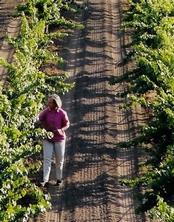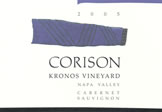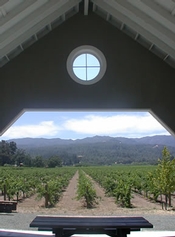(Robert Whitley’s Creators Syndicate Wine Talk column this week)
ST. HELENA, Calif. — When a leading wine publication originally reviewed the 1996 Corison Kronos Cabernet Sauvignon, in 1999, the tasting note indicated it would be optimal to drink between 2001 and 2009. That would be a typical lifespan for many a good Napa Valley Cabernet, and the Kronos was undoubtedly a superb specimen of the genre through its wonder years.
It has now been 14 years since Cathy Corison put away the ’96 vintage in the small French oak barrels she carefully chooses for complexity and nuance. She remembers the vintage fondly and well.
 "It was a very long, cool growing season," she said as we chatted recently. "In fact, we didn’t pick until November. I always thought it was a classic vintage. The ’97 vintage was so ballyhooed that it kept the ’96 in the shadows.
"It was a very long, cool growing season," she said as we chatted recently. "In fact, we didn’t pick until November. I always thought it was a classic vintage. The ’97 vintage was so ballyhooed that it kept the ’96 in the shadows.
"But it has aged very well. I always prefer the cooler vintages. I love the structure. They’re fabulous with food."
As we sat and tasted the ’96, I was reminded of that long-ago review. To my palate, the ’96 Kronos is just now hitting its stride. The primary red and blue fruit flavors continue to shine as secondary aromas of leather, coffee and cedar emerge. This complexity of aroma is the best of times for an older Cabernet Sauvignon, and it comes as the slightly firmer tannins of the vintage have softened with age.
I do not share this with you on the expectation you will dash to the local wine merchant and pick up a bottle of the ’96 Kronos, because that would be impossible. There were only about 400 cases made from this vintage, and most of that has either been consumed or carefully cellared.
My point is simply that Corison Cabernet Sauvignon is a special sort of wine. Cathy Corison, of course, is a special sort of winemaker, so it only stands to reason. She is focused and uncompromising in a world that’s all too ready to catch the next wave.
We took a look at the 1997 Kronos, too, and Corison noted it was "a very ripe vintage." Indeed, the fruit was slightly more dense and darker, the body a bit heavier, but still with the tight structure and faint mineral note of a Corison Cab.
 "Some say it was the first vintage to start this boozy, ripe style," she said. "It was big vintage. Almost double the normal crop. It’s a very good wine. For me, it’s missing some of the red and blue fruit brightness. Still, the wine is under 14 percent alcohol, and I’ve never de-alced a wine in my life."
"Some say it was the first vintage to start this boozy, ripe style," she said. "It was big vintage. Almost double the normal crop. It’s a very good wine. For me, it’s missing some of the red and blue fruit brightness. Still, the wine is under 14 percent alcohol, and I’ve never de-alced a wine in my life."
Corsion never got the memo on the high-alcohol trend.
Or she ignored it. Her style has been consistent throughout her 30-plus years as a winemaker in the Napa Valley, which included stops at Chappellet and Staglin before she opened her own winery just south of St. Helena in 1987.
Her current location is a story in and of itself, because it reveals the nature of the Corison soul.
"My husband got the soil maps and we started looking for vineyards with Bale gravelly loam, somewhere between Ritherford and St. Helena," she said. "That’s where you get the Rutherford dust, which is what made the Napa Valley. That’s the sweet spot."
She enjoyed a good laugh on herself. "I wasn’t asking for much, huh?"
"All of the spots we liked were up against the hills, where people build those trophy homes. That wasn’t for us. Then my husband said, ‘You know, that vineyard out on the highway has been for sale a long time."
The highway was Highway 29, the main traffic artery through the Napa Valley, and the vineyard was Kronos. There were few takers for Kronos at the price, and Corison believes potential buyers were frightened off because they mistakenly thought the vines were rooted on the dreaded AXR1 rootstock, which was susceptible to phylloxera and most likely would have to be replanted.
That turned out to be not true. The rootstock was the even more dreaded St. George, which had been largely abandoned by Napa Valley vintners because of its chronically low yields. Corison and her husband bid on the vineyard and got it. It was a marriage made in heaven. Corsion was more about quality than quantity, so the ton and a half to the acre suited her winemaking style nicely.
 "With these vines, the yields are not only low, which is great for concentration of fruit and flavor, but the sugar accumulation (over the growing season) is slow," said Corison. "While everyone else is picking at 27 degrees of brix (a measurement of sugar level in winegrapes), I’m picking in November and struggling to get to 24."
"With these vines, the yields are not only low, which is great for concentration of fruit and flavor, but the sugar accumulation (over the growing season) is slow," said Corison. "While everyone else is picking at 27 degrees of brix (a measurement of sugar level in winegrapes), I’m picking in November and struggling to get to 24."
What that means in lay terms is that Corsion gets her grapes ripe without the high sugar levels that elevate the percentage of alcohol in the finished wine. To those concerned about the soaring alcohol percentages found in many of today’s table wines, Corsion Cabernet is a tribute to old-fashioned winemaking, a style geared for the cellar.
"All of these styles are just fashion," Corison said. "There were times when it was hard for me to stay the course. I make wines for me, not other people. I believe it’s almost an ethical question. I have a moral obligation to make wines from this great vineyard that will develop in the bottle. That’s my mission."
After tasting the splendidly evolved ’96 Corison Kronos Cabernet, I would say mission accomplished.
8
